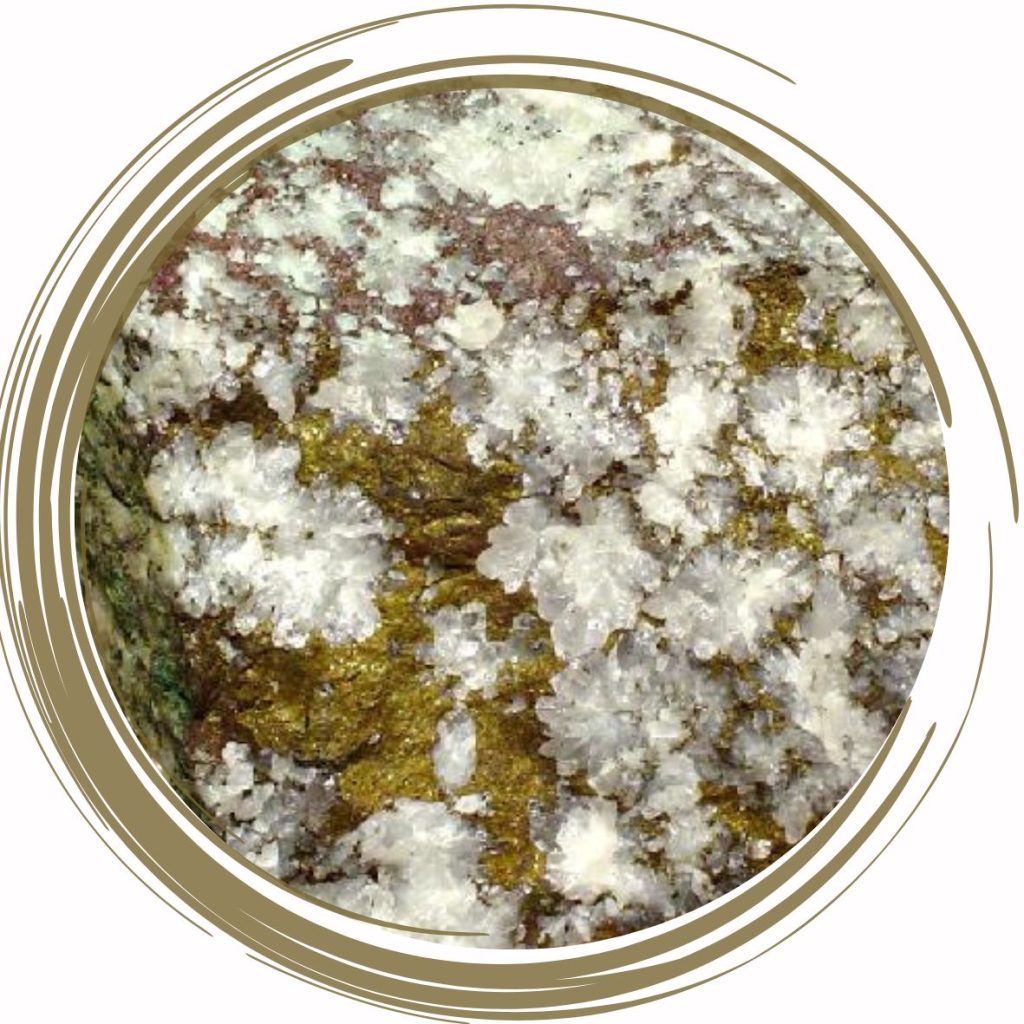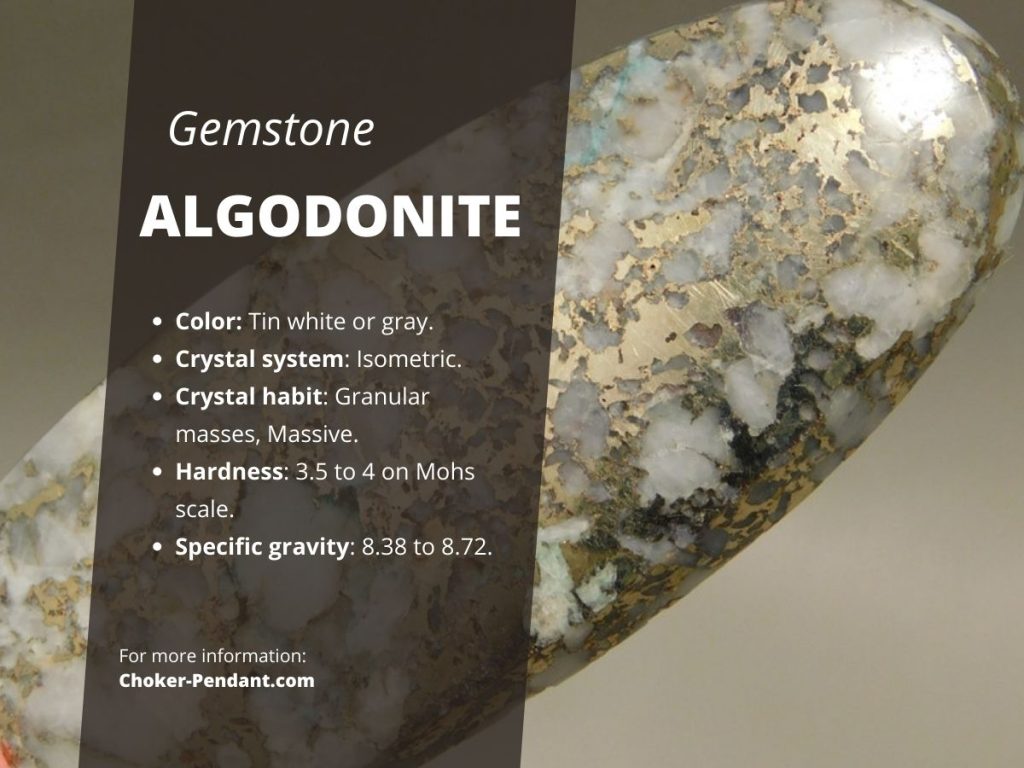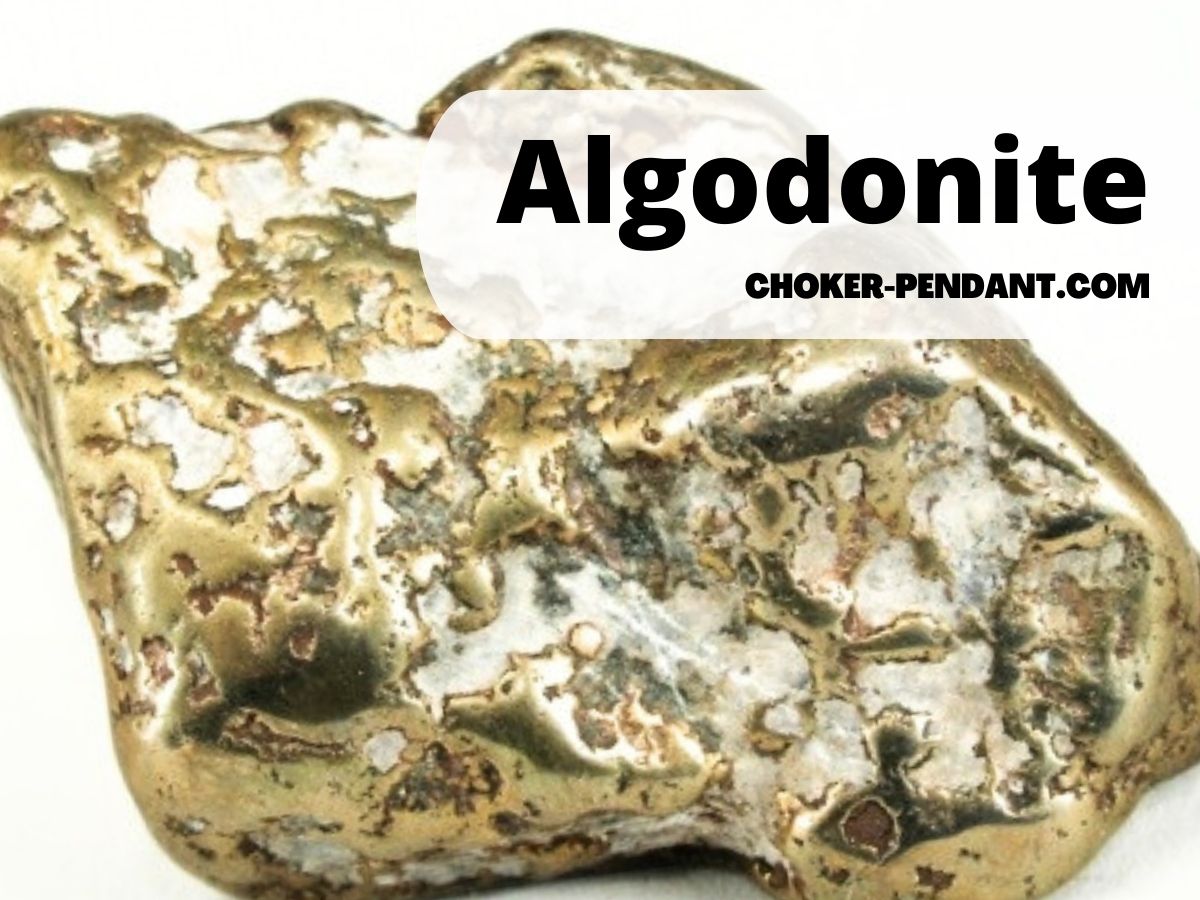What is Algodonite Stone?

Algodonite stone is a mineral that occurs naturally and belongs to the copper-arsenic family. It is distinguished by its characteristic metallic shine and amazing color palette, which ranges from silver-white to brass-yellow with hints of reddish hues.
Because of its fibrous look resembling woven cloth, the name “algodonite” comes from the Spanish word “algodón,” which means cotton. It originates in hydrothermal veins and occurs alongside other minerals such as native copper and silver sulfides. It is composed largely of copper (Cu), arsenic (As), and nickel (Ni).
Algodonite Specifications & Characteristics
| Origin of the name: | Algodonite is named after the Algodones mine in Chile, where it was first discovered in 1846. |
| Group of belonging: | Algodonite belongs to the Native Elements Group. |
| Chemical composition: | Algodonite has the chemical formula Cu6As, meaning it is composed of six atoms of copper and one atom of arsenic. |
| Hardness: | 3.5 to 4 on the Mohs scale. |
| Crystal system: | Algodonite crystallizes in the isometric crystal system. |
| Deposit(s): | Chile, Canada, the United States, and Germany. |
| Cleavage: | Algodonite has three poor cleavages, meaning it tends to break irregularly rather than along smooth planes. |
| Color(s): | Algodonite is typically tin white or gray, but it can also exhibit a tarnished yellow or brownish color. |
| Transparency: | Algodonite is opaque, meaning it does not allow light to pass through. |
| Luster: | Algodonite has a metallic luster, meaning it reflects light in a way that resembles polished metal. |
| Geological occurrence: | Algodonite forms in hydrothermal veins where mineral-rich fluids deposit minerals as they cool. It is often associated with other copper minerals, such as chalcopyrite and bornite. |
Historical Significance
Algodonite stone has historical importance dating back millennia, with numerous cultures acknowledging its outstanding beauty and unique characteristics. This captivating mineral was highly esteemed in ancient Egypt for its visual attractiveness as well as its claimed mystical qualities.
It was used to ornament the pharaohs’ jewelry and holy amulets, representing riches, power, protection from bad spirits, and contact with deities. Furthermore, Algodonite stone is highly valued in Native American civilizations.
Hopi tribes regarded it a holy stone related with healing rites and spiritual practices. Its brilliant hues were thought to depict the flow of energy inside their societies while also fostering peace among individuals.
Algodonite stone occupied a distinct position in society’s awareness across diverse historical periods and places globally, from ancient civilizations like Greece to indigenous tribes in South America, due to its rarity and attraction. It still captivates and inspires jewelry makers, gemstone aficionados, and people looking to connect with the rich tapestry of human history today.
Cultural Uses
Throughout history, Algodonite stone has been employed in various cultural practices for its intrinsic beauty and believed mystical qualities. In addition to its use in decorative jewelry, it found applications in religious artifacts, talismans, and amulets due to the perceived protective energies associated with the stone. These cultural uses highlight how deeply intertwined Algodonite has been with human creativity and spirituality.
Moreover, Algodonite stone’s distinctive colors and metallic allure have made it a sought-after material for artistic expression across diverse cultures. It has been utilized in intricate metalwork designs, sculptures, mask embellishments, and ceremonial regalia.
The utilization of this captivating stone in such significant cultural contexts underscores its enduring legacy as an embodiment of prestige, spirituality, and artistic excellence. In essence, understanding the historical significance and cultural uses of Algodonite stone provides us with invaluable insights into our shared human heritage while illuminating the enduring fascination that this extraordinary mineral continues to evoke today.

Geological Formation of Algodonite Stone
Explanation of the Mineral Composition
Algodonite stone is a remarkable gemstone renowned for its unique mineral composition. It is primarily composed of a copper-nickel alloy, with trace amounts of other elements such as iron and arsenic. The copper content in Algodonite ranges from 50% to 80%, while the nickel content usually falls between 15% and 50%.
The presence of these metals gives Algodonite its distinctive reddish-brown to silver-gray hue, which varies depending on the copper and nickel ratios in the stone. Algodonite’s mineral composition also includes trace amounts of other elements such as sulfur, cobalt, and silver.
These imperfections add to the characteristic pattern and brilliance of the material. Small inclusions or veins of other minerals, such as quartz or calcite, are occasionally discovered inside Algodonite stones, adding to their visual complexity.
Formation Process and Geological Occurrences
Algodonite stones have a fascinating formation process that occurs deep within the Earth’s crust. They are primarily formed through magmatic processes within igneous rocks, specifically sulfide-rich environments associated with mafic or ultramafic intrusions.
During the cooling and solidification of these magmas, metallic atoms such as copper and nickel combine with sulfur atoms to form sulfide minerals. Over time, this process leads to the formation of deposits rich in copper-nickel sulfides, including Algodonite.
Geologically speaking, significant occurrences of Algodonite can be found in diverse regions around the world. Notable locations include Sudbury Basin in Canada, Norilsk region in Russia, Copperbelt region in Africa (especially Zambia), United States (Michigan’s Upper Peninsula), Australia (Broken Hill), and various other localities.
These regions often contain rich mineral deposits formed through complex geological processes involving volcanic activity, hydrothermal systems, and metamorphism. In some cases, Algodonite can also be found as secondary deposits in alluvial or placer environments.
These secondary deposits occur when the original primary sources undergo weathering and erosion, transporting Algodonite minerals downstream and depositing them in riverbeds or sedimentary layers. Understanding the geological formation of Algodonite stone provides valuable insights into its rarity, distribution patterns, and the fascinating journey it takes from deep within the Earth to become a coveted gemstone.
Physical Properties of Algodonite Stone
Color Variations and Patterns
Algodonite stone exhibits a mesmerizing array of colors, making it an enticing choice for jewelry enthusiasts. The most common colors seen in Algodonite are deep shades of gray, silver, and black.
However, it often showcases captivating patterns and metallic sheens that add further allure to its appearance. These patterns can include intricate swirls, mottled patches, or even streaks of coppery hues running through the stone.
Some Algodonite specimens may also display a subtle iridescence or play of colors when viewed from different angles. This versatility in color and pattern makes Algodonite an exceptional gemstone for creating unique and eye-catching jewelry pieces.
Hardness, Density, and Specific Gravity
In terms of physical characteristics, Algodonite is known for its impressive hardness on the Mohs scale. With a rating ranging from 7 to 8 out of 10, it boasts remarkable durability that ensures its longevity in various jewelry applications.
Moreover, this gemstone possesses a relatively high density and specific gravity compared to other minerals. Its density typically ranges from 8.2 to 8.4 g/cm³, while its specific gravity falls between 8.17 and 8.43 depending on the composition variations within the stone.
Cleavage, Fracture, and Luster
Algodonite exhibits a characteristic subconchoidal fracture with uneven or irregular surfaces when broken or cut. While it doesn’t possess perfect cleavage planes like some gemstones do (such as diamond), it still tends to break along certain directions with relative ease due to its crystal structure.
As for luster, Algodonite features a metallic sheen that imparts a captivating shine to the stone. Its luster can range from a bright, reflective shine to a more subdued, satin-like appearance depending on the specific composition and surface treatment.
This unique combination of fracture and luster contributes to the stone’s overall beauty and appeal as a gemstone. Algodonite’s physical properties make it highly desirable for jewelry purposes.
Its hardness ensures that it can withstand daily wear without easily scratching or chipping, making it suitable for use in rings, pendants, earrings, and other adornments. The density and specific gravity contribute to its weighty feel when worn, giving a sense of luxury to Algodonite jewelry.
Additionally, the stone’s fracture characteristics provide interesting possibilities for gem cutters to create unique shapes and designs that showcase its inherent beauty. The metallic luster of Algodonite adds a touch of sophistication and elegance to any jewelry piece in which it is incorporated.
Uses of Algodonite Stone in Jewelry Making
Popular jewelry designs featuring Algodonite stone
Algodonite stone, with its exquisite appearance and captivating blend of colors, has gained popularity among jewelry designers worldwide. Its unique metallic hues ranging from shades of coppery red to silvery gray make it a sought-after gemstone for creating statement pieces. One popular design incorporating Algodonite stone is the pendant necklace, where the mesmerizing gem is often set as the centerpiece to accentuate its beauty.
The warm tones and distinct patterns found in Algodonite stone are also well-suited for crafting elegant rings or earrings that can effortlessly elevate any ensemble. Another trendy approach to incorporating Algodonite stone into jewelry is through mixed gemstone arrangements.
This versatile stone pairs exceptionally well with other vibrant gems such as turquoise, lapis lazuli, or garnet, creating visually striking color combinations and enhancing the overall aesthetic appeal of the piece. Whether used as a solitary gem or combined with complementary stones, Algodonite creates a stunning focal point within various jewelry designs.
Gemstone cutting techniques for enhancing its beauty
Gemstone cutting techniques play a pivotal role in accentuating the inherent beauty of Algodonite stone. Due to its metallic composition and layered patterns, lapidaries often employ specific cutting styles to maximize its visual impact.
One popular technique is the cabochon cut which involves shaping the gem into a smooth dome-like form without any facets. This cut highlights the intriguing patterns present in Algodonite stone and allows light to reflect off its surface, showcasing its unique metallic hues.
Another cutting approach employed by skilled artisans is faceting, which involves meticulously shaping flat surfaces known as facets onto the gemstone’s exterior. Faceted cuts can enhance not only the brilliance but also emphasize different areas of color within Algodonite stone, creating a dynamic and visually appealing gem.
The choice of cut depends on the lapidary’s vision for the final jewelry piece and how they wish to emphasize the stone’s natural characteristics. In addition to traditional cutting techniques, some designers opt for more unconventional approaches when working with Algodonite stone.
Irregular or asymmetrical cuts are gaining popularity as they emphasize the stone’s organic and raw beauty, giving each piece a distinct and one-of-a-kind appearance. Such cutting styles provide an alternative perspective on showcasing Algodonite stone’s vibrant colors while maintaining its natural allure.
The craftsmanship involved in cutting Algodonite stone requires precision and expertise to ensure that its exquisite patterns are properly showcased. Whether using traditional cabochon or faceted cuts, or exploring unique and contemporary styles, jewelry designers continue to explore innovative methods that bring out the best in this captivating gemstone.
Healing Properties and Metaphysical Beliefs Associated with Algodonite Stone
Energy properties and chakra alignment
Algodonite stone is believed to possess powerful energy properties that can harmonize and balance the body’s energy centers, also known as chakras. In particular, this stone is thought to resonate with the heart chakra, promoting emotional healing and compassion.
When placed on or near the heart, Algodonite stone is believed to stimulate love, forgiveness, and empathy. It is said to help dissolve emotional blockages and foster a sense of inner peace.
Emotional healing benefits
Algodonite stone is highly regarded for its emotional healing benefits. It is thought to alleviate feelings of stress, anxiety, and depression by promoting a sense of calmness and tranquility.
This stone encourages self-awareness and introspection, empowering individuals to confront deep-seated emotions with courage and compassion. Some believe that Algodonite stone can aid in releasing past traumas or emotional wounds by encouraging forgiveness towards oneself and others.
Spiritual connections and metaphysical associations
Beyond its emotional healing properties, Algodonite stone holds significant spiritual connections in various belief systems. It has been associated with enhancing spiritual growth, connecting individuals to their higher selves or divine consciousness.
Some metaphysical beliefs suggest that Algodonite stone can facilitate communication with angelic beings or spirit guides. Its serene energy is said to promote a deeper understanding of one’s life purpose while aiding in meditation practices by quieting the mind.
Famous Examples of Algodonite Stone in History
Notable jewelry pieces or artifacts containing Algodonite stone
Throughout history, we find splendid examples of jewelry pieces adorned with exquisite Algodonite stones. One notable example is the stunning necklace worn by Queen Victoria, featuring a central Algodonite pendant surrounded by diamonds.
The intricate craftsmanship and the vibrant hues of the stone highlight its regal beauty. Additionally, ancient Egyptian pharaohs often cherished Algodonite stone for its association with royalty and power, adorning themselves with bracelets, rings, and amulets encrusted with this captivating gem.
Historical figures associated with the use or appreciation of this stone
Many historical figures have shown a deep appreciation for Algodonite stone. Cleopatra, known for her love of precious gemstones, adorned herself with Algodonite jewelry to enhance her allure.
Leonardo da Vinci was captivated by the unique properties of Algodonite and incorporated it into his artwork as a symbol of wisdom and spiritual enlightenment. These historical figures recognized the exceptional beauty and metaphysical significance of Algodonite stone.
Rarity, Availability, and Market Value
Limited sources worldwide
Algodonite stone is relatively rare and occurs in only a few locations worldwide. The primary sources include South Africa, Russia, Canada, Australia, and certain regions in Central Europe. Due to its scarcity in nature, it is highly coveted by gemstone enthusiasts who appreciate its unique blend of colors and patterns.
Factors influencing market value
Several factors contribute to the market value of Algodonite stones. The quality of color variations like rich blues blended with golden hues or striking contrasts can significantly impact their worth.
Size also plays a role; larger specimens are generally more valuable than smaller ones. Additionally, clarity without visible flaws enhances desirability.
Collectibility among gemstone enthusiasts
Algodonite stones have gained considerable popularity among collectors due to their rarity combined with their captivating aesthetics and metaphysical properties. Many gemstone enthusiasts seek out Algodonite specimens to add to their collections, appreciating their unique and alluring beauty.
Interesting Facts about Algodonite Stone
Lesser-known historical anecdotes
In ancient Greek mythology, Algodonite stone was associated with the sea goddess Amphitrite, symbolizing her calming and soothing nature. It was believed to bring protection to sailors during tumultuous voyages. Furthermore, in Chinese culture, Algodonite stones were regarded as symbols of purity and enlightenment.
Unique characteristics or features
Algodonite stone exhibits a fascinating interplay of colors and patterns due to its mineral composition. It showcases mesmerizing shades of blue often blended with intricate golden veins or spots that resemble cotton fibers—hence the name “Algodonite,” derived from the Spanish word for cotton.
Uncommon uses beyond jewelry making
Aside from its prominent use in jewelry making, Algodonite stone has found applications beyond adornments. In architecture and interior design, it is occasionally incorporated into decorative elements such as countertops or wall coverings for an elegant touch. Its unique appearance adds a touch of sophistication and natural beauty to any space it graces.
Care and Maintenance Tips for Algodonite Stone Jewelry
Cleaning methods to preserve its luster
To maintain the luster of your Algodonite stone jewelry, gently clean it using mild soap or specialized gemstone cleaner mixed with lukewarm water. Use a soft brush or cloth to remove dirt or oils accumulated on the surface. Avoid exposing your jewelry to harsh chemicals, including household cleaners or perfumes.
Storing guidelines to prevent damage
Store your Algodonite stone jewelry separately from other pieces in a soft pouch or lined jewelry box. This helps prevent scratches and ensures the gemstone remains protected. Furthermore, it is advisable to avoid storing Algodonite jewelry in direct sunlight or extreme temperature conditions to maintain its vibrant colors.
Precautions to avoid exposure to harsh chemicals
Algodonite stone is sensitive to harsh chemicals, so it is essential to remove your jewelry before engaging in activities that involve contact with chemicals, such as swimming or cleaning. Chemicals can potentially damage the stone’s surface and diminish its luster over time.
Conclusion
The metaphysical powers of algodonite stone are noteworthy as well as its visual attractiveness. Because of its potential to align chakras and promote emotional healing, it is a popular gemstone among people seeking balance and tranquillity. The usage of this stone in famous jewelry pieces worn by important persons throughout history demonstrates its historical significance.
Despite their scarcity, Algodonite stones continue to draw collectors and enthusiasts alike owing to their unique mystical connotations and compelling beauty. Whether treasured for its historical narratives or respected for its applications other than jewelry manufacturing, Algodonite stone is a remarkable gemstone cherished by those who realize its amazing features.




